Have a Question?
VP2430/VP2440 Component and Operating System Compatibility (+Known Issues)
Overview
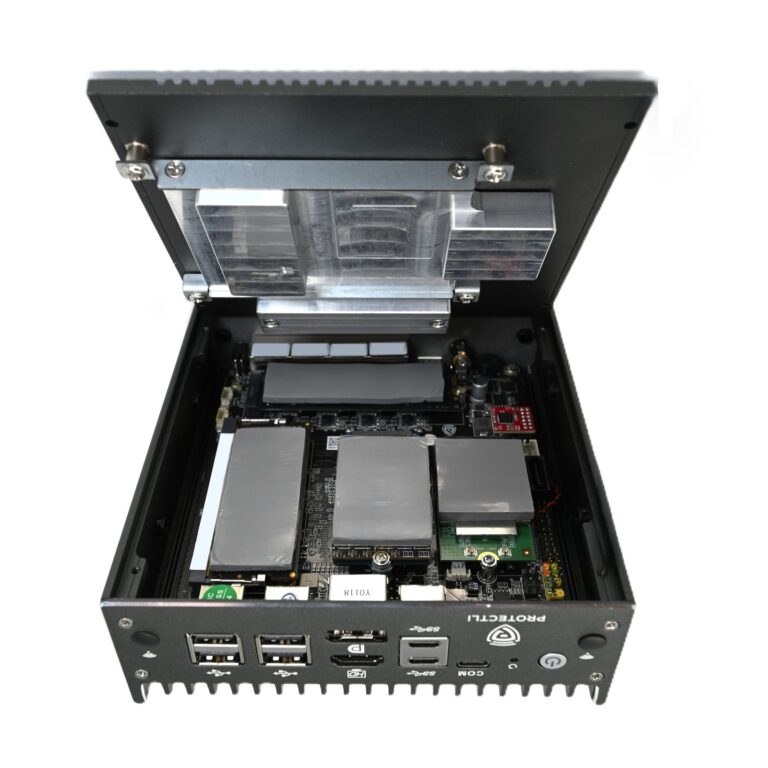
The Vault Pro VP2430 and VP2440 utilize certain standards of hardware components, and it is important to be familiar with what is and isn't supported in regards to specific components and operating systems. There are many options for storage, RAM, WiFi cards, and other components in relation to manufacturer, models, and specifications. This article is created to inform current/future VP2430 and VP2440 owners on what kinds of components and operating systems are compatible.
At the very least, RAM is required for these units to boot. NVMe storage is recommended to install an operating system to, but isn't necessarily required to actually turn on.
The official datasheet for the VP2430 can be found at this link. The Hardware overview article can be found at this link.
The official datasheet for the VP2440 can be found at this link. The Hardware overview article can be found at this link.
Known Issues/Quirks List
General:
- If a 16GB Crucial DDR5 module (specifically CT16G48C40S5.C8A1) is being used, and the user stays on the firmware menu (AMI or coreboot) for a variable amount of time (anywhere from 5-15 minutes), the screen may rapidly start flashing, tearing, and causing graphical artifacts. This does not occur after booting into an OS, but seems to only affect the firmware menu accessed by holding "Delete" key at boot
- Wake on LAN (WOL) is disabled on Port 1 by default when using coreboot firmware, but works on every other port (this affects RJ-45 Port 1 on the VP2430 and SFP+ Port 1 on the VP2440)
- AMI firmware disables the "Sleep" option on Windows, Ubuntu, and similar OS's. This issue is not present when coreboot firmware is flashed to the unit.
- A known issue with i226-V Throughput Degradation on coreboot is outlined on our Techincal Service Bulletin (TSB-2025-001)
- If OPNsense is installed on the eMMC while utilizing coreboot firmware, a label will be created on the partition titled "Samsung BJTD4R 81BA3514 eMMC User Data"
- On coreboot, in the event that your firmware has an issue and you receive a warning regarding booting to the recovery firmware partition, pressing the "Enter" key to start the boot process will automatically boot into the first boot option rather than allowing you to press "Delete" or "F11" to access the coreboot menu or boot options. Please press the "Delete" or "F11" before pressing "Enter" to negate this.
Operating System Compatibility
Protectli verifies compatibility with a wide range of operating systems for all Vault and Vault Pro products, and the VP2430/VP2440 is no exception. If an operating system is available to be preinstalled by us, it is certainly compatible. However, we do qualify other operating systems that we do not preinstall.
In order to qualify an operating system we go through a series of tests to verify it can be installed and function normally. This includes verifying that all hardware aspects work as expected, and documenting fixes for issues we find. Some operating systems offer near-endless possibilities in regards to configuration, so we cannot test every single use case, but the OS's listed below that are marked as compatible can be installed and can run for extended periods of time without issues. If you find any issues with an operating system, feel free to let us know. If you see that we have qualified an older version of an operating system and a new version has released, you may still be able to install the newest version, but always backup your configuration before updating the OS.
| Operating System | Version Tested | Compatible? | Notes |
|---|---|---|---|
| OPNsense | 25.7 | Yes | On coreboot, the VGA installer tries to default to Serial output. You should still see video, but you may not see certain messages on the console during the booting phase |
| pfSense® CE | 2.8 | Yes | |
| FreeBSD | 14.2 | Yes | |
| OpenBSD | 7.6 | Yes | |
| IPFire | 2.27 | Yes | |
| Ubuntu | 22.04/24.04 | Yes | Linux Kernel 16.2 or newer required for proper video/audio output |
| Debian | 12.10.0 | Yes | Must manually update Linux Kernel to 6.12 or newer to use the OS above 800×600 resolution and for audio output to function |
| Windows | 11 | Yes | Run all Windows updates, use Intel INF Chipset Utility, and update Intel Graphics Drivers |
| Windows | 10 | Debatable | We recommend installing Windows 11 instead. Windows 10 is reaching "end of support" status. Driver support for the NICs on Windows 10 are not ideal, and GPU drivers must manually be updated |
| Proxmox VE | 8.3 | Yes | Serial installation may report AER errors during installation when a WiFi card is installed |
| XCP-ng | 8.3/8.2.1 | Yes | On coreboot, you may see an error message at boot mentioning "EFI_MEMMAP not enabled" (this is okay and is not a problem), please wait upwards of 2 minutes for the operating system to finish loading |
| VMware ESXi | 8.0.3 | Yes | The Intel N150 CPU is not on Broadcom's compatibility guide. Long term support and stability is unknown. |
| OpenWrt | 24.10 | Yes | |
| Arista NG Firewall (Untangle) | 17.3.0 | Yes | Older versions of the OS will not work due to lack of i226-V support |
| Sophos | – | No | Sophos requires legacy BIOS and doesn't support 2.5GbE NICs |
| VyOS | Rolling Release | Yes | |
| CentOS | 10 | Yes | All required video/audio/etc drivers included in initial install |
| Fedora Workstation | 41 | Yes | |
| openSUSE Tumbleweed | Current (2025 versions) | Yes |
Memory (RAM, DDR5 SODIMM)
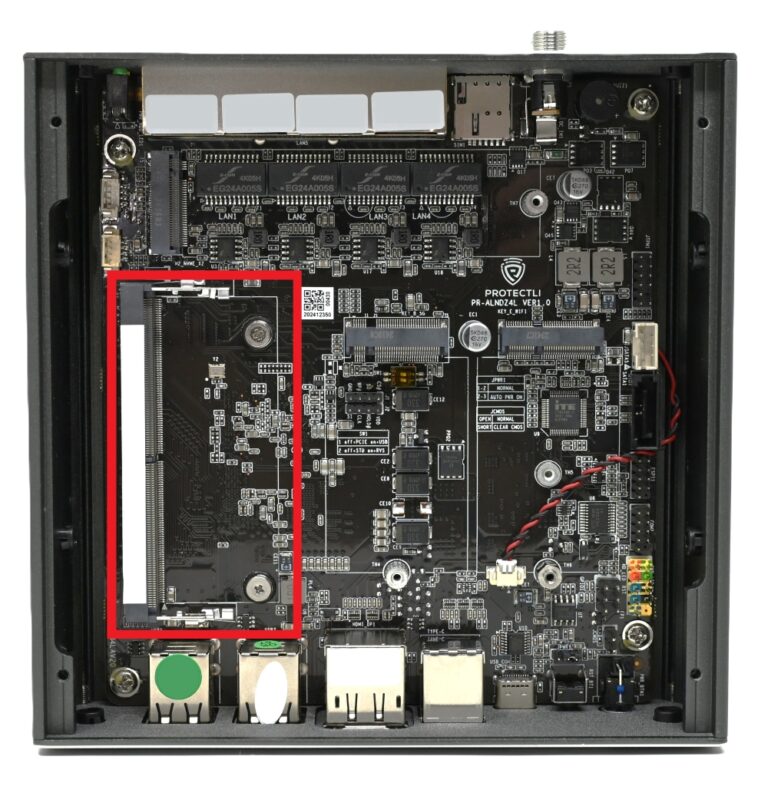
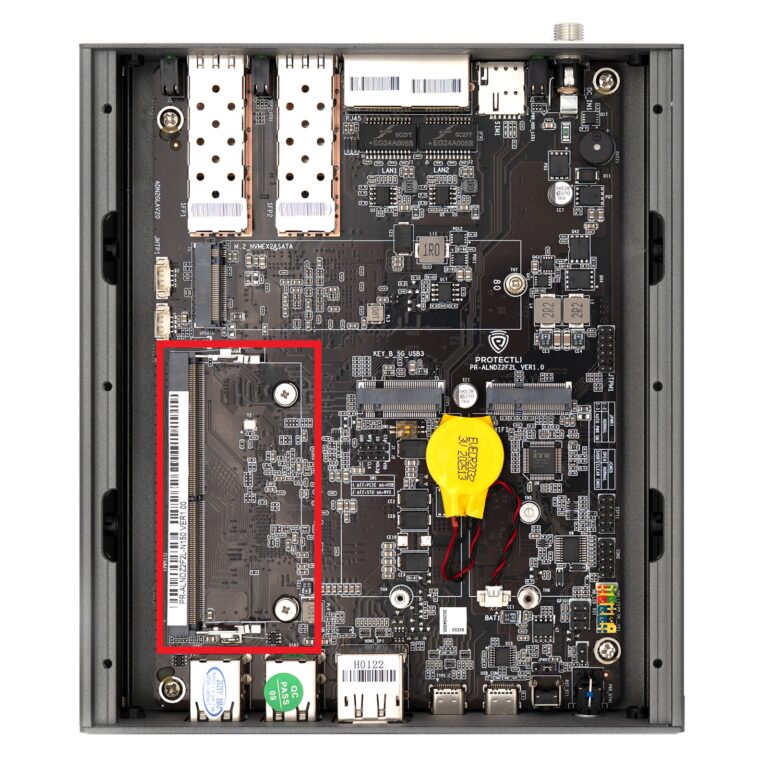
The VP2430 and VP2440 feature a single DDR5 SODIMM slot, supporting memory speeds of up to 4800MHz. While the official Intel® spec sheet states that the N150 CPU supports a maximum of 16GB of memory, we've successfully tested modules well beyond that limit. Specifically, we've used 64GB, 48GB, and 32GB RAM modules from various manufacturers without issues. We confirm the compatibility by ensuring the Vault boots, is able to install various operating systems, and that the entire RAM module is seen and that every byte can truly be utilized. We also conduct long-term memory tests via MemTest86 as well as stressing various operating systems for weeks at a time.
If you're planning to source RAM above 16GB on your own, we recommend exercising caution. If you purchase a module we've confirmed to work with the VP2430/VP2440 from a source other than Protectli, there's still a small risk of incompatibility or performance issues. This can arise from subtle differences in chipsets or variations in the country of manufacture. We've encountered situations where identical RAM models that were previously compatible became problematic after changes in their manufacturing location.
Modules that we have personally tested and confirm to work can be found lower down in this section.
Physical Socket
There is one physical socket for RAM. It is a 262 pin SO-DIMM for DDR5 memory. There is a notch in the memory module that matches the socket so that only the proper type of memory can be physically inserted into the socket. Other standards of RAM will not fit.
Speed
The speed of memory access is determined by the CPU and firmware settings. It is recommended to use RAM that is rated for at least 4800MHz (the default and highest speed allowed by the CPU).
Within the AMI Setup Menu (accessed by holding the Delete [DEL] key at boot), you can lower the speed that RAM runs at by going to Chipset > System Agent (SA) Configuration > Memory Configuration > Maximum Memory Frequency.
coreboot firmware does not currently have a feature built in to affect memory speeds, and will always default to 4800Mhz.
DDR5 RAM Modules Confirmed to Work by Protectli
We are continuously updating this list as we test more RAM. Please check back every once in a while to see any changes.
| Vendor | Model | Country of Origin | Speed (MHz) | Size (GB) | AMI | coreboot |
|---|---|---|---|---|---|---|
| Crucial | CT8G48C40S5.M4A1 | Mexico | 4800 | 8 | Yes | Yes |
| Crucial | CT16G48C40S5.M8A1 | Malaysia | 4800 | 16 | Yes | Yes |
| Crucial | CT32G48C40S5.M16A1 | Malaysia | 4800 | 32 | Yes | Yes |
| Crucial | CT64G56C46S5.M16B1 | Malaysia | 5600 | 64 | Yes | Yes |
| Kingston | KVR48S40BS6 – 8 | Taiwan | 4800 | 8 | Yes | Yes |
| Kingston | KVR48S40BS8 – 16 | Taiwan | 4800 | 16 | Yes | Yes |
| Kingston | KVR56S46BD8 – 32 | Taiwan | 5600 | 32 | Yes | Yes |
| Kingston | KVR56S46BD8 – 48 | Taiwan | 5600 | 48 | Yes | Yes |
| Mushkin | MRA5S480FGGD48GX2 | Mexico | 4800 | 48 | Yes | Yes |
DDR5 Modules Confirmed to Work by Customers
| Vendor | Model | Country of Origin | Speed | Size | AMI | coreboot |
|---|---|---|---|---|---|---|
| Crucial | CT32G48C40S5.C16A1 | Malaysia | 4800 Mhz | 32GB | Unknown (not tested, but most likely works) | Yes |
| Team Group Inc | TED532G5600C46A | Taiwan | 5600 Mhz | 32GB | Yes | Unknown (not tested) |
DDR5 RAM Modules that FAILED QUALIFICATION
| Vendor | Model | Country of Origin | Speed | Size (GB) | Issue |
|---|---|---|---|---|---|
| Crucial | CT16G48C40S5.C8A1 | Mexico | 4800 | 16GB | Common BSOD w/ Windows 11 |
| Crucial | CT16G48C40S5.M8A1 | Mexico | 4800 | 16GB | Common BSOD w/ Windows 11 |
If you have tested a module that is not presented in these lists, please let us know the results! (Contact support@protectli.com via email or ticket)
Storage (NVMe SSDs, 2.5" SSDs)
M.2 NVMe SSD
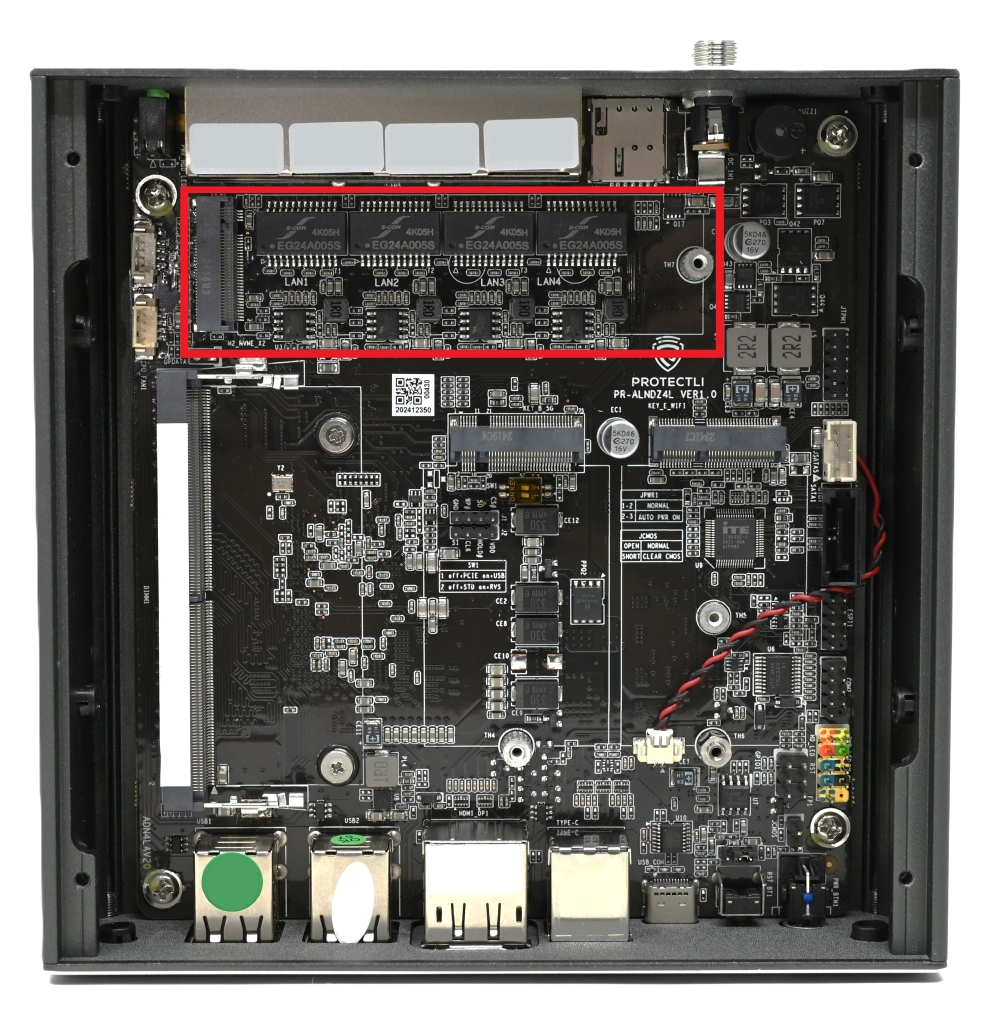

The Vault Pro VP2430 and VP2440 contain a M.2 2280 slot designed for use with M.2 NVMe SSDs. This slot operates at PCIe Gen 3 x2, so NVMe from newer generations and drives that support more PCI lanes will downclock to that spec.
There is very little likelihood of incompatibilities with NVMe SSDs, assuming the NVMe you are using is the correct form factor and PCIe Generation.
All NVMe SSDs available from Protectli will work with this unit. This includes Samsung, Kingston, and Phison branded drives. Other well known and high quality drives should work.
The standard storage capacities of 250GB, 500GB, 1TB, 2TB, 4TB, etc are compatible.
If you just installed a new NVMe SSD and do not see it in the BIOS/UEFI menu, do not be concerned. In many cases, the drive will not be seen in the BIOS/UEFI until it is partitioned or an OS is installed to it.
2.5" SATA SSD
The VP2440 does not support a 2.5" SSD. There are no SATA headers on the motherboard.
The VP2430 supports a single 2.5" SATA SSD that can be mounted to the internal brackets found on the bottom plate, inside the unit. If you wish to use a 2.5" SATA SSD, you will not be able to install the large component heatsink that cools RAM, WiFi Cards, and Modems since it uses the same brackets to be mounted.
No known incompatibilities have been found with 2.5" SATA SSDs. Standard SATA Storage capacities are supported.
WiFi Cards (WiFi 5, 6, 6E)
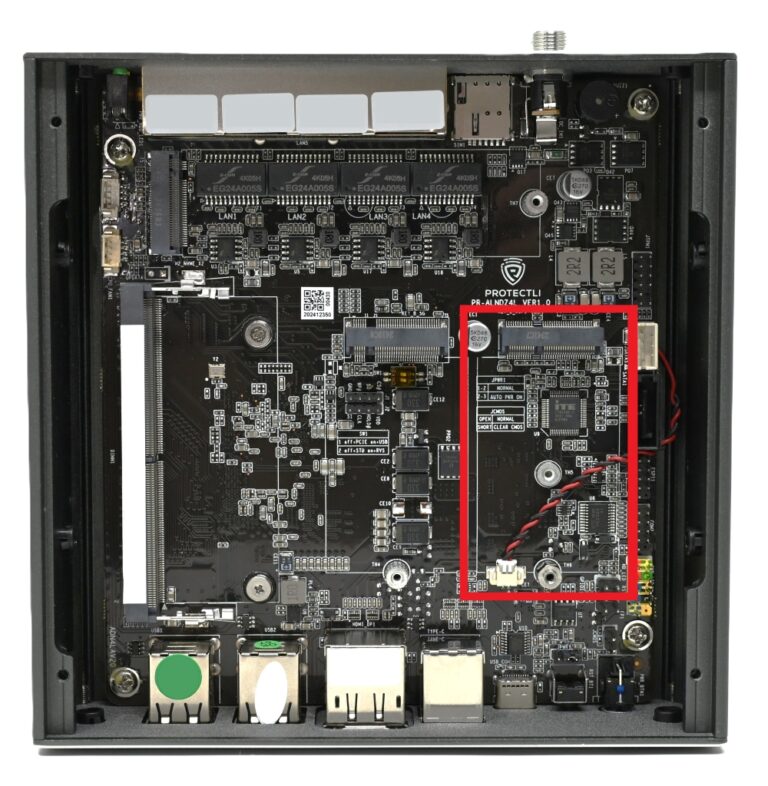
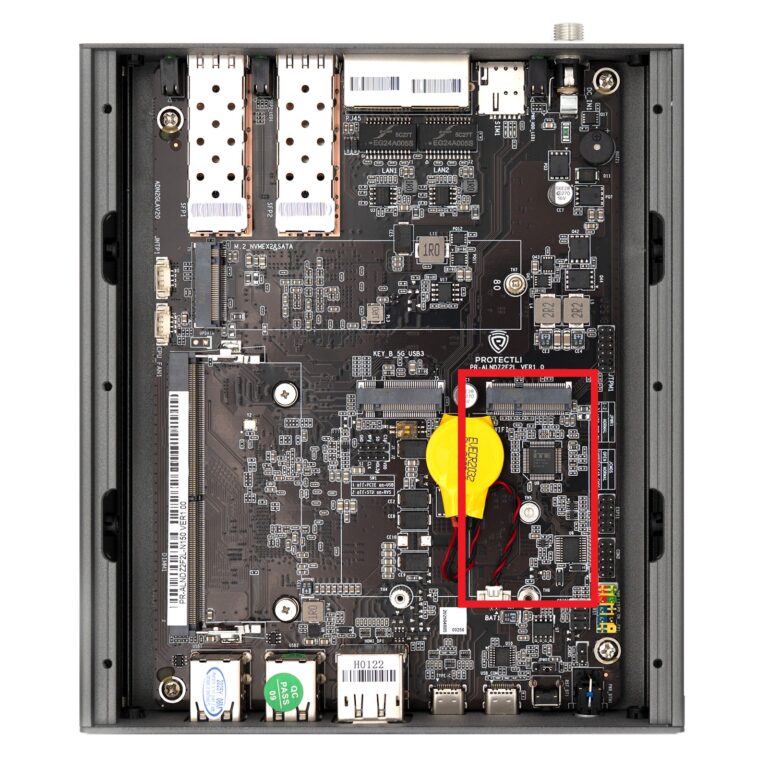
Found on the motherboard is a M.2 E-Key 2230/3052 slot designed for use with WiFi cards in mind. This slot operates at PCIe Gen 3 x1. There is a standoff screw that can be moved in order to accommodate the size of your WiFi card (2230 or 3052).
M.2 WiFi cards purchased from Protectli will work with the VP2430. Additionally, the VP2430 has the ability to support a WiFi 6/6E card.
As long as your desired WiFi card is M.2 2230 or 3052 in size, does not require more than a single PCIe Gen 3 lane, and your OS has supported firmware, you shouldn't have issues. It is highly recommended to use thermal pads and the internal heatsink if utilizing a WiFi 6/6E card. Some WiFi 6/6E cards may use upwards of ~8.0W under heavy use.
We have had very good results with WiFi cards that use Mediatek chipsets such as MT7916, MT7915, and MT7612 with OpenWrt and Linux distributions.
WiFi 5, 6, and 6E cards do not work with OPNsense or pfSense®, but are perfect for use with many Linux operating systems and are especially great for OpenWrt. Always remember to install the required drivers for the WiFi card on the operating system you are utilizing.
Please note: WiFi 7 cards are not entirely recommended to be used with the VP2430, although some may work. Many WiFi 7 cards benefit from having multiple PCIe lanes, and the VP2430 offers only one on this slot. You will realistically achieve similar throughput speeds on a WiFi 6E card.
Modems (4G/5G)
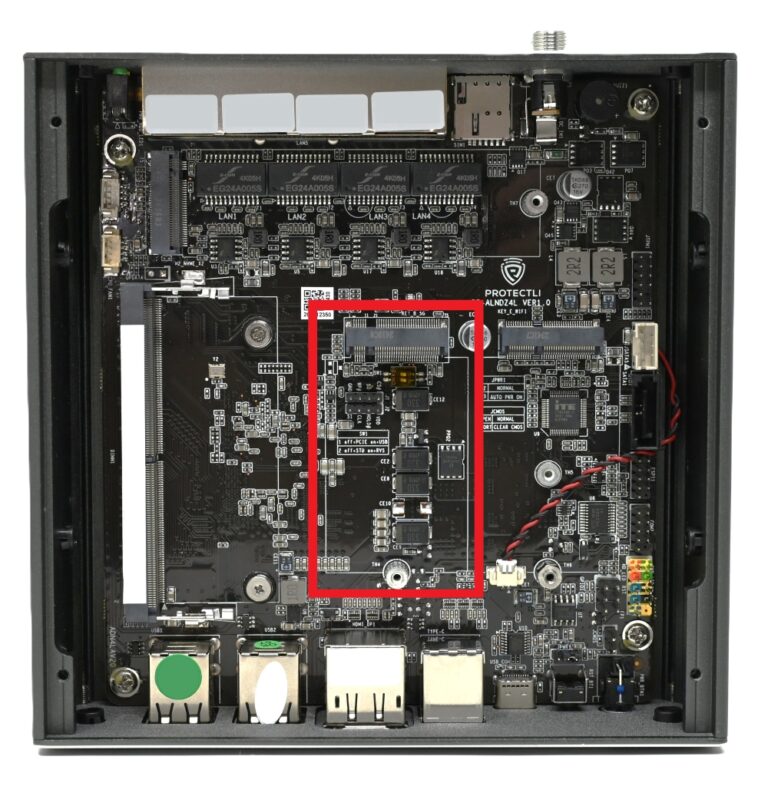
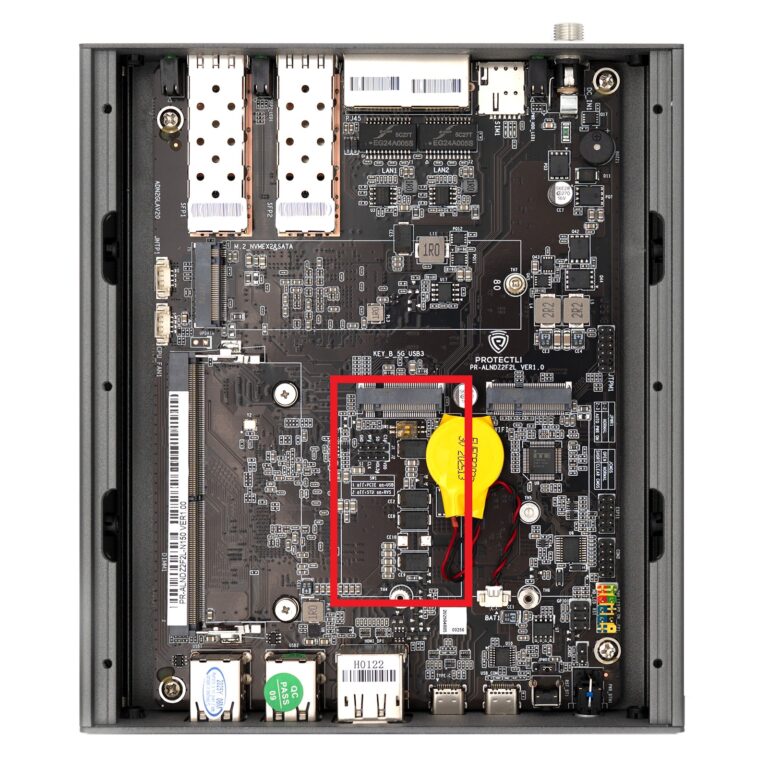
The final slot we will review is the M.2 B-Key Modem slot. This slot operates on a USB 3.2 Gen 1 protocol. Both 4G and 5G modems are supported.
If you plan on using a modem from a source other than Protectli, please review the specs/datasheet of the modem to verify that it meets the specification of the VP2430's modem slot.
Some modems may use Pins 20 and 22 for adding additional control functions and could be used as voltage sensing pins. Some modems will not work unless proper voltage is applied to specific pins. If you have a modem that requires this, you can utilize the two switches labeled "SW1" on the motherboard (found next to the Modem slot) to affect Pin 20 and 22 voltage. The switch labeled "1" will affect Pin 20 Voltage between 0V and 1.8V. The switch labeled "2" will affect Pin 22 Voltage between 0V and 3.3V. Further information on this header can be found on the datasheet (item #17 within internal interfaces section).
Internal Modems purchased from Protectli do not require those switches to be moved or modified.
Conclusion
If you have used a component not listed on this article, please let us know what it is, if it does/doesn't work well, and your testing process.
As always, feel free to reach out to us if you require clarification or have any questions. Some of your questions may be answered from the VP2430 Hardware Overview article or the VP2440 Hardware Overview article. If you need to reach out, check out our contact information!
